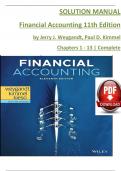Exam (elaborations)
Solution Manual For Financial Accounting, 11th Edition by Jerry J. Weygandt, Paul D. Kimmel, Verified Chapters 1 - 13, Complete Newest Version
Solution Manual For Financial Accounting, 11th Edition by Jerry J. Weygandt, Paul D. Kimmel, Verified Chapters 1 - 13, Complete Newest Version Solution Manual For Financial Accounting, 11th Edition by Jerry J. Weygandt, Paul D. Kimmel, Verified Chapters 1 - 13, Complete Newest Version Solution Manu...
[Show more]



